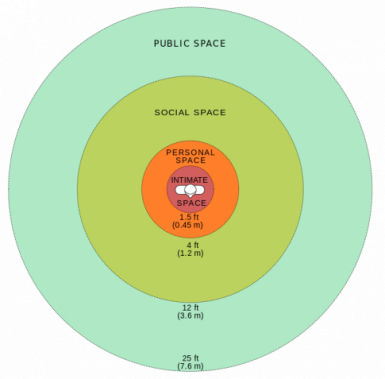As a security officer, the idea of reasonable force is a hotly contested issue in the industry, but something which is just as important, perhaps, even more, if personal space. The distance between two people can often affect a particular reaction from a person, so getting the personal space aspect of the role down could make the difference.
The Science of Personal Space
Believe it or not, you can actually categorise personal space. These categories were defined by Edward Hall, who classified them as a series of rings around one’s self. The closer towards a person moves towards another, the more intimate space it becomes.
Meaning that a good understanding of personal space, firstly allows you to judge distance from an attack and secondly can defuse or escalate a situation, depending on where you are.
Getting in too close to a person can cause a sense over overbearing and can make a situation stressful, however, being too far away can decrease authority and increase detachment.
Rings of Personal Space
The rings of personal space are defined as follows
- Public Space – 25ft to 12ft away
- Social Space – 12ft to 4ft away
- Personal Space – 4ft to 1.5ft away
- Intimate Space 1.5ft and closer

Public Space
This space is considered for the general public and people we don’t know. In this space we don’t feel much ownership for that person or situation.
Social Space
Generally, this space is reserved for strangers and new acquaintances. In this area, we feel comfortable letting people in. If a conflict arises in this area, it is noticed but is not considered a threat.
Personal Space
We feel comfortable letting groups of friends into this space. This area is reserved for people who we have known and who we are comfortable with. If a conflict arises in this space, it is considered important.
Intimate space
This space is reserved for people who are close to us. Normally reserved for close friends, family member or lovers, this is an area that was guard considerably. If a conflict arises in this area, it is normally followed by a physical confrontation and you need to be prepared to use reasonable force to deal with it.
Controlling Your Space
Knowing the limits of people’s spaces is important, a lot of people have varying limits of what they consider to be personal space. Knowing this can enhance your communication skills in everyday situations.
Understanding body language is also key to managing personal space and the combination of the two can help get you out of some potentially sticky situations.
Always have the rings in mind when you’re working and they will keep you in good stead.
Putting it into Practice
With the knowledge of personal space theory, we can now assess how to manage a scenario and come up with the best strategies on solving them without escalating.
In short, the idea is not to stand too close to someone. During a confrontation, when you start to invade the personal space and intimate area, emotions often start to ramp up.
However rules are made to be broken and if a situation calls for an “in your face” approach and you can be sure that it will rapidly diffuse a situation, then, by all means, go for it, just remember that close personal space is a protected area and when you invade that space, there are consequences.
Using personal space is a way to gain control over a person and a situation, so use it wisely and you can manage it, quickly and effectively.
The Goldilocks Zone
Every individual is different and the Goldilocks zone cannot be defined by one particular area. The Goldilocks zone is all about judging things like communication, body language and overall signals, which should tell you it’s either safe to move closer or that your presence is aggravating them.
A security officer is a very public role, so make sure you make customers feel safe when you’re around them and knowing the rules about communication and personal space, should help make your shift a little bit easier.




